How to Hire Freelancers for Your Business Using Delegation in 2024
You’re busy, but don’t know how to delegate. It’s a catch-22 situation. We created the ultimate guide on delegating work to skilled freelancers and getting back your time.
 February 7, 2023
February 7, 2023 24 minute reading
24 minute reading
“I quit my 9 to 5. Now I work 24x7.”
Hit a little too close to home?
It’s no secret that small business owners are some of the busiest people, working between 40-49 hours/week on average. Work never really ends, and you’re likely strategizing, emailing, or just plain stressing during off-duty hours.
In a 2021 study, 65% of small business owners say they are “closer than ever to burning out”.
Delegating and outsourcing work is a clear solution — giving business owners more time and resources to focus on tasks that require their expertise. But how do you identify what tasks to delegate, and who to delegate them to?
We spoke to 27 business owners about their delegation process and how they use freelancers to operate at scale.
Let’s look at how you can find the best freelancers and successfully delegate work to them.

The Flexible Talent Report
Get to know the outsourcing trends & benchmarks of companies like yours.
Download ReportWhat is delegation?
Delegation is the transfer of task responsibility to a person with better-suited priorities and expertise.
The ability to delegate is a core leadership skill, creating more time to focus on higher-priority tasks.
It’s nearly impossible to maximize personal productivity if you’re trying to take on everything yourself.
You’re not playing to your strengths and could be on the fast track to burnout.
For many business owners, delegating has clear benefits.
“I wouldn’t be a multi-six-figure business and working with large brands if I didn’t delegate,” says Haley Slade, CEO and founder of Slade Copy House. “No successful CEO got to the top on their own. When you delegate, you change the trajectory of your business”.
Most small businesses delegate these tasks to freelancers:
Blogging and content creation: If you’re planning to grow your businesses distribution and online presence, you can easily delegate this to experienced freelancers. For blogging, you’d need content strategists, SEO experts and ghostwriters. If you’re starting a Youtube channel, you’d need a script writer, videographer, and professional video editing experts..
Social media management: Running social media profiles is a full-time job, and can easily be delegated to a social media expert.
Data entry: It doesn’t get more menial than punching numbers into a file, and most business owners could spend their time on more important tasks. Data entry experts can organize and manage your data.
Graphic design: Whether it’s a flier, packaging design, or Instagram post, a freelance graphic designer can learn your brand aesthetic and regularly meet your design needs.
Email management: If you’re running email campaigns and drowning in your inbox, an email marketer can organize and manage this for you.
Programming: Small businesses can have one-off programming or development needs that don’t justify hiring a full-time full-stack developer.
Why does delegation feel so difficult?
If delegation is the obvious choice, why do so many business owners struggle with it?
There are a few emotional drivers that can make delegating work feel like a hurdle.
Saving money is a top priority for startup founders. “It's tough to hire a freelancer for a task you know you could do yourself,” says Tory Jon, founder of CamperFAQs. “It can feel like a waste of money!”
Trying to do everything yourself saves money spent on outsourcing but can cost you in terms of business growth.
“Initially, I had a habit of doing everything myself to save money.” says Henry Schultz, founder of Salty Endeavors. “But if I do everything, something is bound to suffer, whether that’s customer service, finances, or even my personal life.”
Solopreneurs also worry about delivering sub-par quality if they don’t touch every single aspect of the work. This can stem from the desire to control all aspects of your business to ensure perfection, which could be counter-intuitive for business growth.
“Most of my issues as a business owner were because of my nature to control everything. I would mask behind my self-efficacy.” admits Ken Marshall, founder of Best Freelance Tools. “Now automation and delegation have given me back my time and mental clarity.”
Top benefits of delegating
Lindsey Walker, CEO of Walker & Associates, was forced to hire freelancers after a Stage IV cancer diagnosis. “Since then, we’ve seen tremendous growth in our productivity, the clients we serve, and ultimately in our bottom line.”
After overcoming initial delegation anxiety, small businesses can enjoy multi-fold benefits from delegating to freelancers. The top benefits were higher productivity, fewer chances of burnout, and a higher capacity to take on more work and clients.
Benefit 1: Higher productivity
Multi-tasking can reduce productivity by 40%, going against the natural focus patterns of the brain. Redirecting your attention to the most important aspects of your business can result in a higher success rate.
“The biggest benefit we’ve seen is a reduce in administrative burden.” says Lisa Dietrich, Partner at girokonto. “Thanks to freelancers, we have more time and resources for areas of growth and development within the company”.
Benefit 2: Access freelance talent and expertise outhouse
Another top benefit is accessing freelance talent and expertise outside of the company, resulting in higher efficiency and quicker time to market. According to a 2021 Deloitte study, 78% of businesses achieved standardization and process efficiency thanks to outsourcing.
“We could tap into a wide range of expertise thanks to freelancers,” says Max Benz, CEO of BankingGeek. “We've been able to expand our services faster than ever before and increase our reach within the industry.”
Benefit 3: Reduce costs
Hiring freelance talent can save your business costs in the long-run, especially from employee turnover costs, training costs, and office space and supply costs, or even statutory holidays.
A Deloitte study shows 88% of business owners achieved cost reduction when outsourcing work to contractors.
Benefit 4: Better work life balance
We spoke to founders who also shared being able to spend time on what really matters to them, improving their work-life balance and taking time off.
“I learned it is much more efficient and inspiring to not only surround yourself with great colleagues, but to delegate tasks that don't use my expertise to freelancers.” says Andrew Gonzales, co-founder of BusinessLoans.com. “Instead of doing tasks myself, I can outsource and review for accuracy. I don’t need to sacrifice time with my family anymore.”
Fiverr’s own design team looked to freelancers on Fiverr Business to completely re-invent our brand identity — and ended up with stunning and visually-aesthetic designs. With a global talent pool, the possibilities for successful collaboration are endless.
How to hire a freelancer: 6 Steps for successful delegation
We’ll admit — it’s not always a simple task to find a talented freelancer. Especially if you’ve never delegated work to a freelancer before.
We’ve created six steps to successfully delegate work to freelancers:
Identify which tasks need to be delegated
Define your budget
Find freelancers
Vetting freelancers
Create an SOP
Retain a long-term freelance team
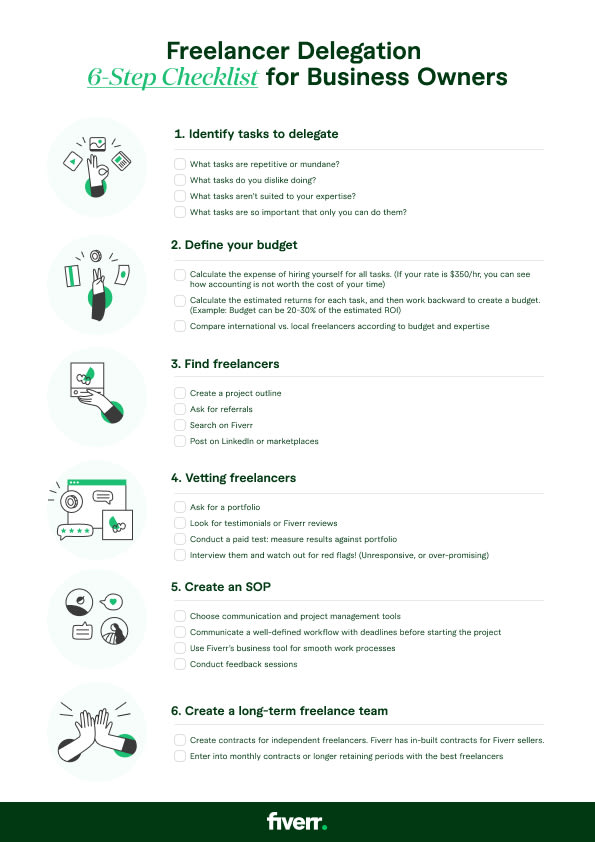
Download our free delegation checklist here so you can apply our process to your business repeatedly.
Get the templateStep 1: Identify which tasks need to be delegated
How do you know which tasks to give to a freelancer, handle in-house, or taken care of yourself?
Here's our advice.
Delegate repetitive tasks
Look at which tasks are repetitive, mundane, and require little executive decision-making. For example, bookkeeping, sending invoices, and responding to email queries may be tasks you do on ‘auto-pilot’. They eat up a lot of your day, leaving you with less time for more important work like strategic planning and big-picture goal setting.
Hire a professional virtual assistant who can take care of the nitty-gritty in your day.
Delegate tasks you dislike
If certain tasks feel like a chore, and you dread getting them done – chances are you don’t do them as often as you should. Outsourcing them will make sure these tasks get done, and that you don’t ruin your day working on them.
“I start off by defining the problem, my ideal outcome, and start making lists in a Google Sheet,” says Marshall. “At first, I made a matrix and asked myself what tasks I really disliked doing, that took up a ton of time, but that also didn't earn the business very much money. Those tasks were removed from the business or delegated immediately through a freelancer or software.”
Kaleigh Moore, in her newsletter, talks about outsourcing all the tasks she loathes.
“The first tasks I outsourced were those I hated. These were the number-related aspects of my business, like paying taxes, retirement investing, and bookkeeping. Yuck!”.
She outsourced these and freed up mental bandwidth. “That was an investment I would make repeatedly for my sanity, if nothing else.”
Do you also dislike accounting and bookkeeping? Get it off your plate with trusted Fiverr Accounting experts.
Delegate tasks below your payroll
CEOs don’t run coffee errands. Why should you invest time in tasks below your pay grade?
A great way to determine if a task is worth doing is to create an hourly rate for yourself. Most business owners figure their hourly rate is between $150-350. Not sure how to calculate it? Use quick napkin math to divide your annual desired income by 12 months, then again by the hours you work monthly, and add tax.
For example, if you want to earn $80k per year, it'd look like this:
$80,000 ÷ 12 months = $6,666/mo
$6,666 ÷ 120 hrs/mo (30 hours per week) = $55/hr Now, calculate the total cost of hiring yourself to do all company tasks. Turns out, you’re a very expensive employee — fire yourself and hire someone else!
Andrew Gonzales uses this method to identify delegation tasks.
“If I say my hourly rate based on my education and expertise is $150/hr, I can assess if a task is worth $150/hr.” says Gonzales. “Analyzing our quarterly finances and preparing a budget proposal for an investor? That's worth my hourly rate. Pasting a blog post into WordPress? That would be an overspend of my time when I could outsource that work for less than my hourly rate.”
Delegate high-volume tasks
Even if a task is worth spending your time on, you’re placing a ceiling on your business growth if you plan to work on it alone. “I delegate tasks that made me burn out the most,” says Mariya Delano, Founder of Kalyna Marketing. “I love writing, but I can only write for a few hours in any week before I feel my brain shutting down.”
Find highly skilled freelancers that can take on your overflowing work. While it may be tough to find freelancers with the exact skill level as yours, look for highly rated freelancers that can be trained or brought up to speed with minimal resources.
What not to delegate?
So what tasks should you leave for yourself or in-house employees?
Apart from dealing with strategic planning and high-consequence decisions, you may not want freelancers to work on certain projects.
“The tasks I keep in-house are the high-level strategy, project management, and client-facing tasks.” says Karli Jaenike, Founder of Wild Idea.
Safeguarding your product ideas and confidentiality is important, especially if you don't have a non-compete clause with your freelancer.
“If it involves private information about the company or higher level work with customers, I manage in-house.” says Lisa Riggs, CEO of Spirit Sox USA. “I would really have to vet a freelancer if I were to give them access to our customers.”
Step 2: Define your budget
The same work can be completed for $50 or $500 — but the end result will be drastically different. That’s not to say pricier freelancers are always better, but pricing can give insights into experience and quality of work. This applies to most service industries, like getting a haircut or your car engine fixed.
Freelancers’ hourly rates vary depending on their industry, work experience, and geographical location. Essentially, freelancers are entrepreneurs running their own businesses. They have rent, bills, and taxes to pay just like you. Businesses spend an estimated $4,700 per new hire on recruitment and training. When you hire skilled freelancers, there’s no learning curve or training period, which saves you a lot of time and money. “There shouldn’t be a huge training investment or learning curve for freelancers, invest in experts of respective fields,” says Luciano Viterale, founder of Luciano Viterale Consulting.
Start by creating a project budget. This is the total amount you’re willing to spend to hire talent, complete the particular project, and all tasks involved. It should also account for any paid tools or resources you need for project completion.
Calculate expected return on investment
Not sure how much to pay freelancers for a service?
Calculate the estimated return on investment for project completion. Sometimes ROI is hard-cash conversions, but there can be other end-goals like lead generation or brand visibility.
For example, you want to create a 3D animation video that'll walk your customer through using your product. You’ll be able to monitor the click-rate on your animated infographic video, and ultimately the conversions as well.
Set aside a percentage of your ROI as the budget for the project. For example: If you expect $10,000 revenue from the infographic video, setting a 20% budget would be $2,000.
Compare prices on marketplaces
You probably have a clear idea of the quality of work you’re looking for.
Use freelance marketplaces to search for freelancers that match the expertise you want, and see their hourly or project rates. A marketplace helps you compare freelancers to each other to get a ballpark figure of what to expect.
Small bootstrapped businesses don’t always want to invest top-dollar for freelancers. Still, we spoke to experts who say investing in a quality freelancer has long-term benefits.
“My advice to small business owners who aren't used to working with freelancers? Don't lowball them or cut corners. Offer a fair rate and invest in quality.” says Jaenike.
Cutting corners and hiring the cheapest labor available might save you an initial investment, but could lead to low-quality work that has to be constantly re-worked.
Even worse, it could set you back.
For example, a website made by a web developer without technical SEO expertise will likely rank low on Google — defeating the project’s purpose. You’d have to shell out more for an experienced developer to go back and fix the hack job.
Similarly, poor brand design could give off the wrong impression to your users, hampering sales.
Compare local vs. international freelancers
One of the biggest benefits of hiring remote freelancers is that you can access talent across the globe. International freelancers living in low-cost-of-living countries may charge less than higher-cost living countries. For instance, a motion designer from Bangladesh will charge differently from one living in Australia — even if their knowledge and skills are comparable.
Highly skilled freelancers typically charge industry top rates regardless of where they live since they compete on experience rather than location.
Freelancer Map’s study in 2022 found a drastic difference in the average hourly rate across continents. The average hourly rate in North America and Europe is $96, while the average rate in Asia, Africa and South America is $53-54.
Note that this is a self-reported study, and the numbers don’t specify the freelance service or account for quality, skill, and experience.
“I think there is a big misconception around foreign freelancers being subpar or cheap,” says Andrew Gonzales. “Raise your budget if you want better expertise, and you'll find that any freelancer with a respectable rate has earned that price tag regardless of nationality.”
Also, it’s important to be tax compliant when processing payments to freelancers overseas. Since documentation varies across tax authorities in different countries, deducting and claiming rebates can be complicated.
If you live in the USA, you need to submit a 1099-NEC for American resident freelancers, but your company doesn't need to pay or report taxes for international freelancers.
Instead, you can collect a W-8BEN form from foreign freelancers. If you’re hiring a freelancer on Fiverr, nation resident or international, you don’t have to worry about tax compliance, since Fiverr manages this for you.
Step 3: Find Freelancers
You’ve identified delegation tasks and you have a budget. Now you need to find the right freelancers.
But where do you find them?
Most business owners find freelancers on marketplaces, Linkedin, or through referrals.
“Finding the right freelance talent can be a bit of a challenge depending on the market, the job we are hiring for, etc.” says Lindsay Walker. “We find most of our freelancers from Fiverr.”
Create a job description
There are two purposes to creating a job description.
One, you get crystal clear on your own expectations from the project and the freelancer. Two, if you decide to search on job boards and social media, a detailed job description attracts the right freelancer and sets expectations on project requirements.
Job descriptions are like those used when searching for a full-time employee.
So it should include:
A description of all responsibilities and deliverables (include specific quantities — for example, 12 hours of virtual assistance, 50 hours of API programming)
Any prerequisites — niche industry experience, or familiarity with tools.
Scope of work — how long you expect the project to go on for, or the volume of tasks.
Examples and links to previously done work. This sets the precedent and can convey more to freelancers than the job description can describe.
A preferred completion date.
You might also want to include the budget in the description.
This is a tricky subject because business owners don’t want to overpay if they could’ve gotten a freelancer for less.
However, Kaitlyn Arford makes a compelling case for why freelance rate disparity is an issue.
“Superpath found that white content marketers make $21,498 more than BIPOC people.”
Another study by Zen Business revealed that male freelancers charge 48% more than female counterparts. Arford suggests adding a minimum project rate, or rate range according to experience. If you’ve already prepared a budget, consider publishing it with your job post for more transparency.
Here’s a great example of a job description:
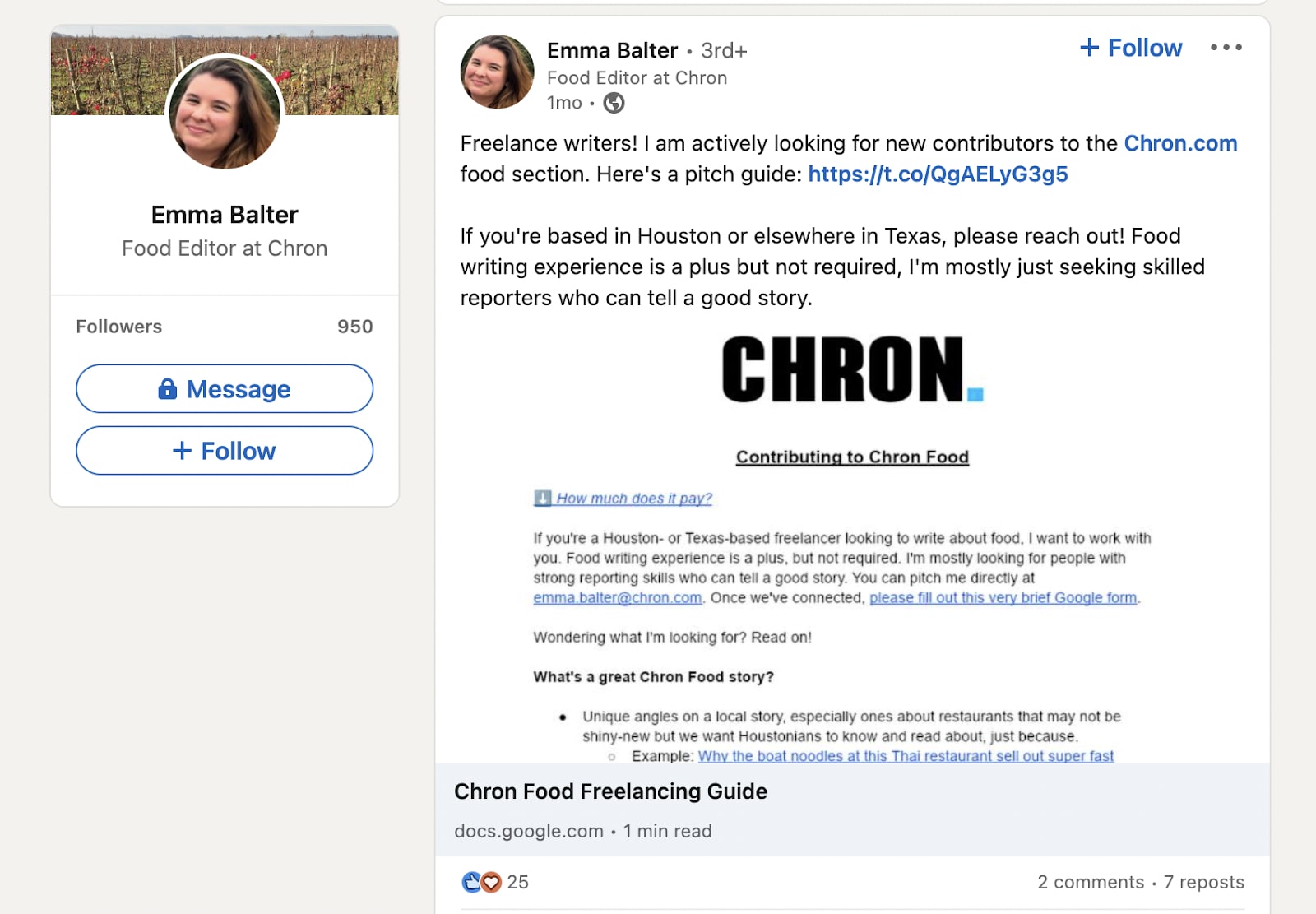
Emma Balter, on Linkedin.
Emma Balter posts a quick call for freelance writers with the essential requirements, and includes her job description as an attachment, so the post isn’t too lengthy.
If you don’t have the time to write a job description, consider hiring a Fiverr expert to do it for you. The job description will come in handy throughout the freelancer recruitment process.
Ask for Referrals
You might think the gig economy works on referrals as an exception — but data reveals this isn’t true!
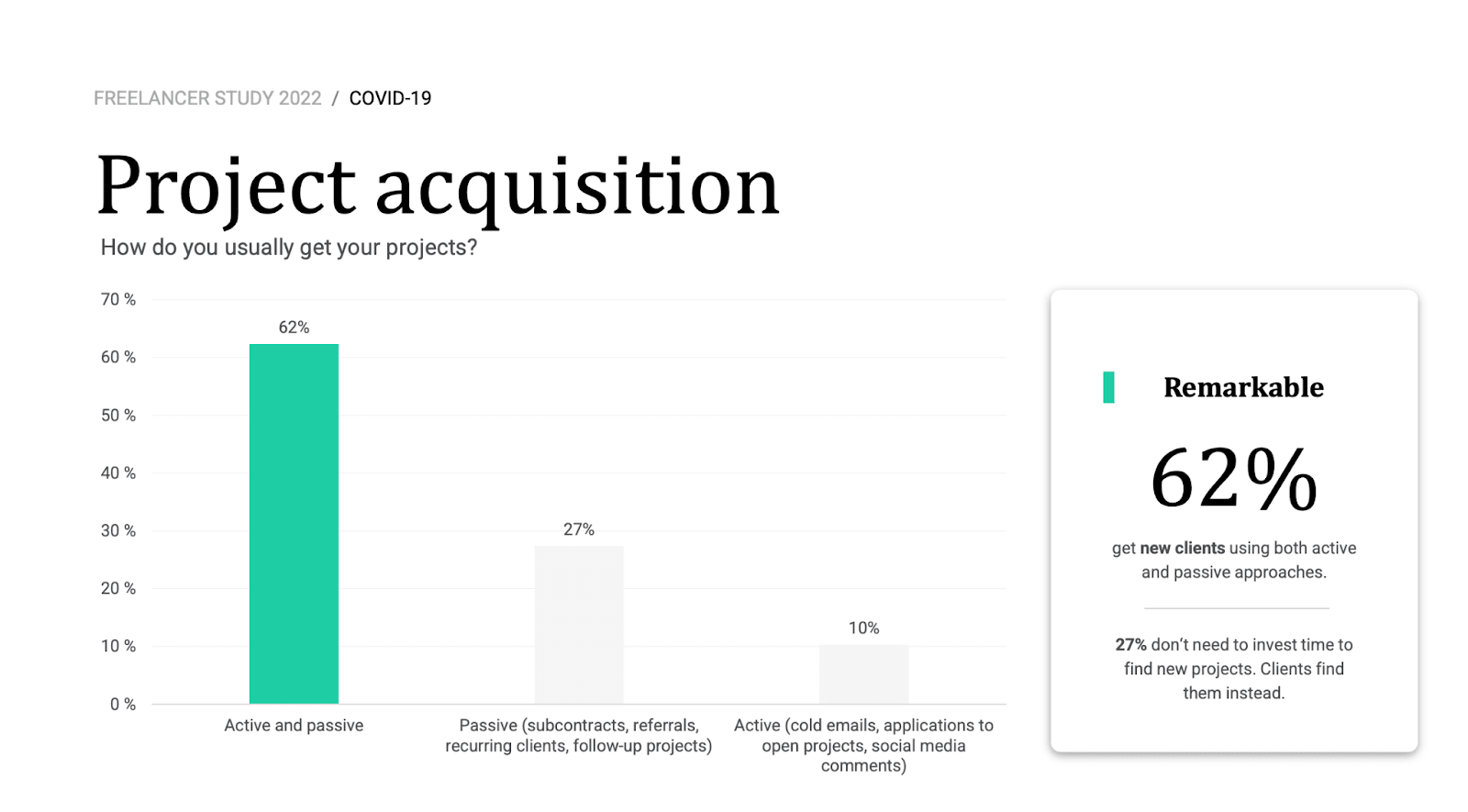
Source: Freelancer Map
Freelancer Map’s 2022 study reveals that passive forms of project acquisition (inbound) are almost 3x more common than active forms like cold outreach. However, most freelancers have a mix of both.
This shows the power of referrals and why you should leverage them. So reach out to your professional network to ask for recommendations or inquire about projects they previously outsourced. As long as you’re not reaching out to your direct competitors, most business owners are happy to network and provide a recommendation.
Quick tip: Check out the ‘Given’ section in Linkedin profile recommendations. If you’ve found a website you like, but don’t know the business owner, they might have left the website designer a LinkedIn recommendation.
Find your freelancers on Fiverr
Referrals are so effective because we love social proof.
That’s why Fiverr includes reviews in seller profiles. This simplifies finding reliable help other business owners find useful. It's the next best thing to having someone vouch for the reliability and quality of a freelancer.
From website developers and graphic designers to voice-over artists and virtual assistants — Fiverr houses the best freelance global talent pool. By filtering your requirements on Fiverr, you can view thousands of freelancers that match.
Here’s how to find freelancers on Fiverr:
Sign up on Fiverr
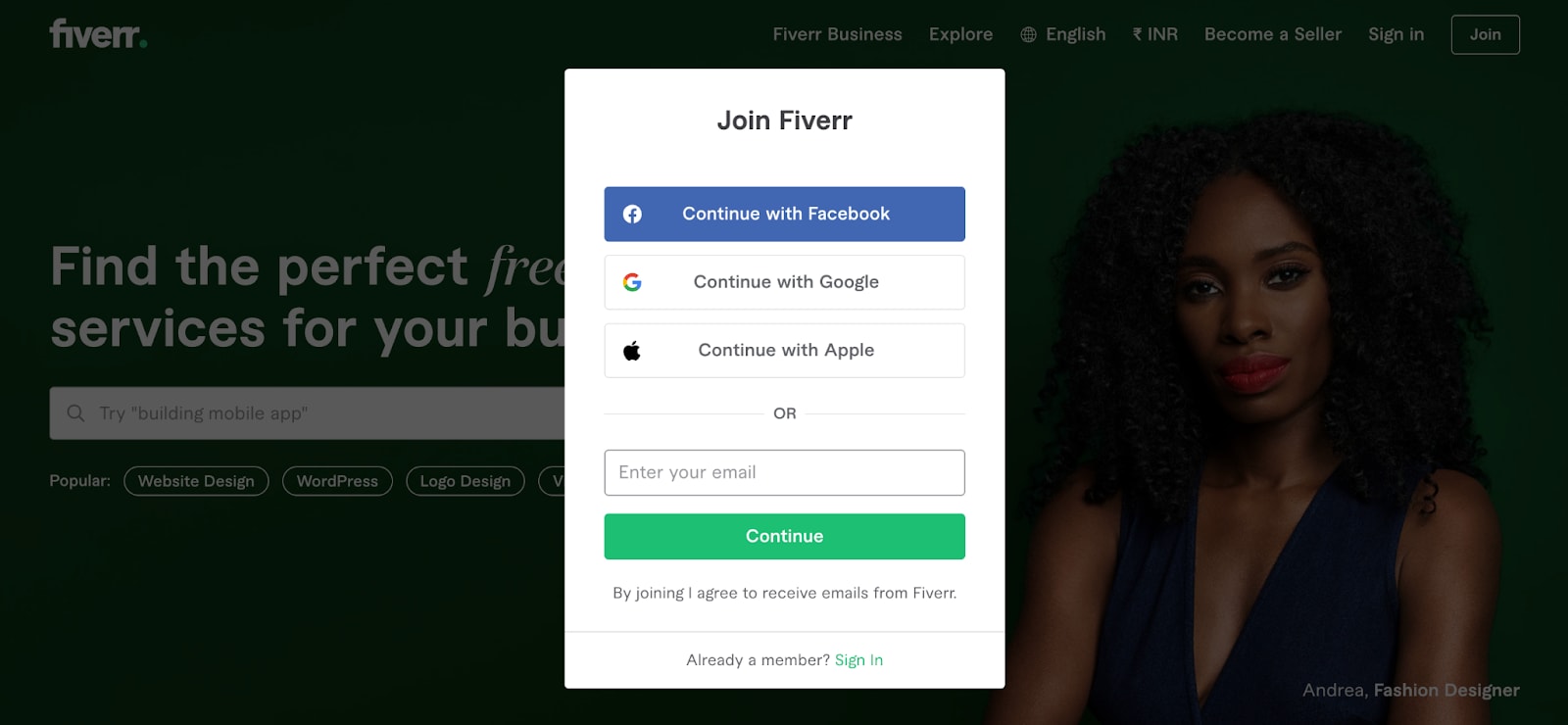
2. Search for the service you’re looking to delegate. Let’s suppose you’re looking for an SEO expert.
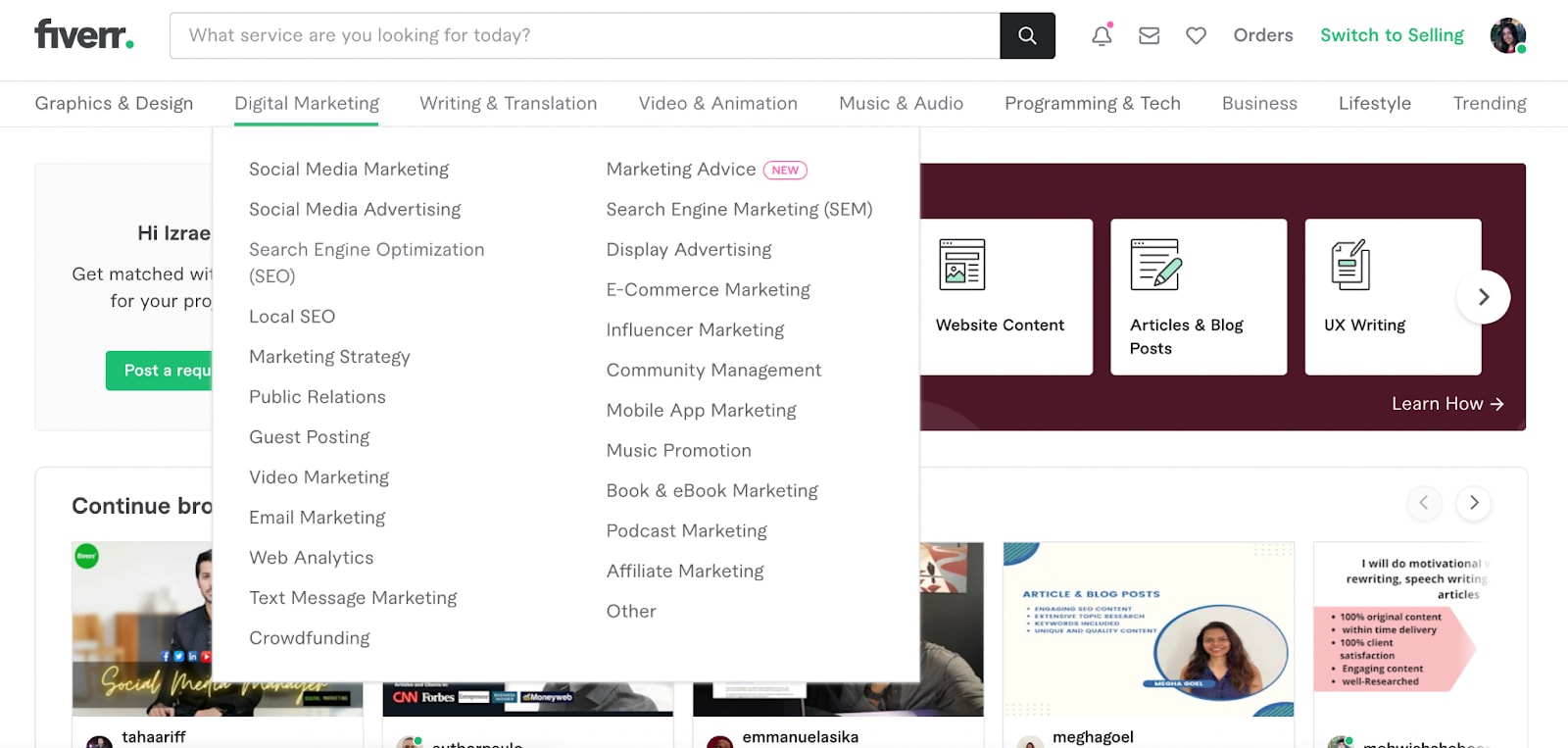
3. Narrow down your search to the exact task you need completed.

4. Filter your search by ratings, budget, location and even delivery time.

5. Find a seller you like and explore their pricing plans.
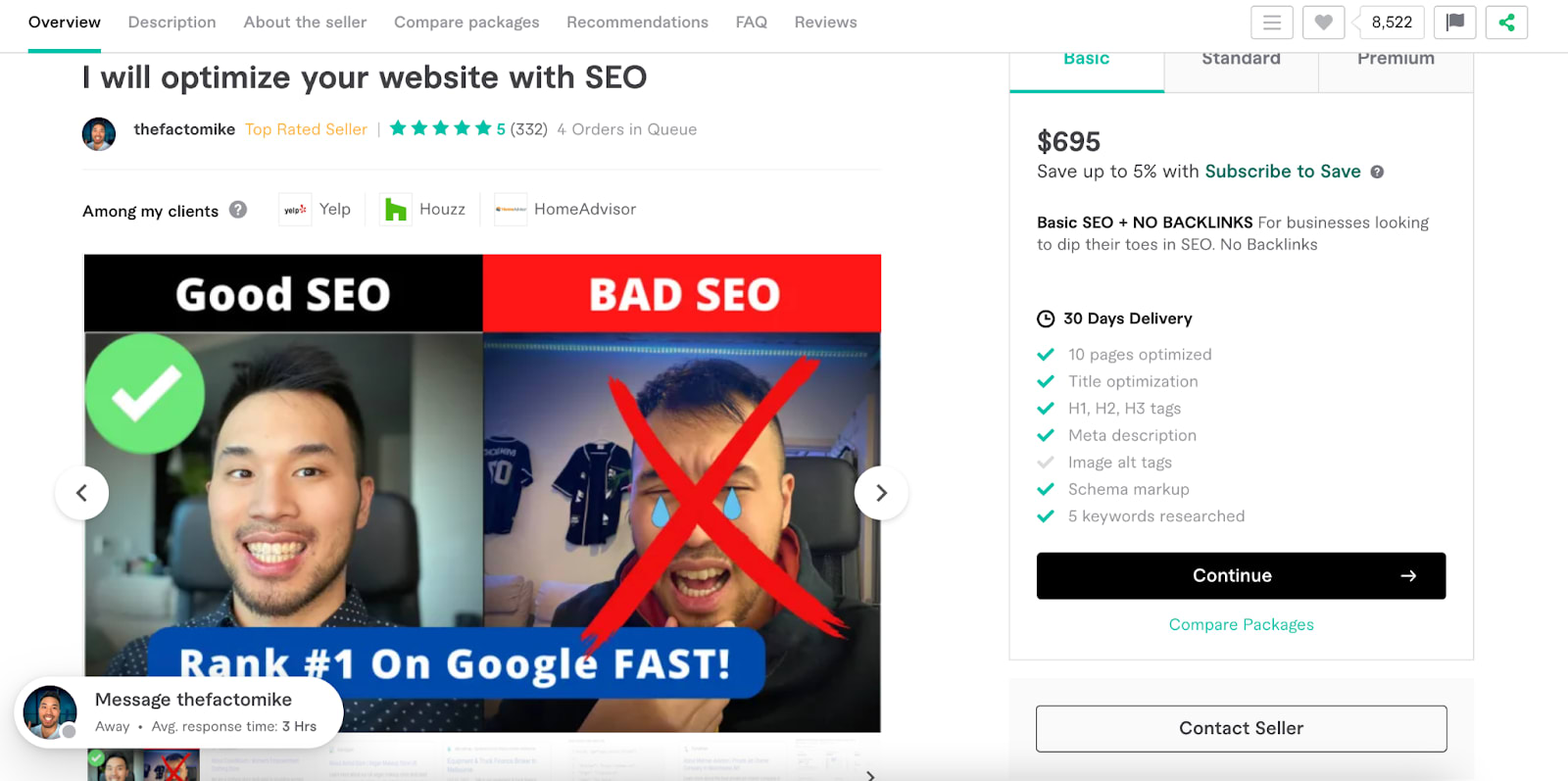
Source: Fiverr thefactomike
6. Go through the reviews

7. Contact the seller with your requirements
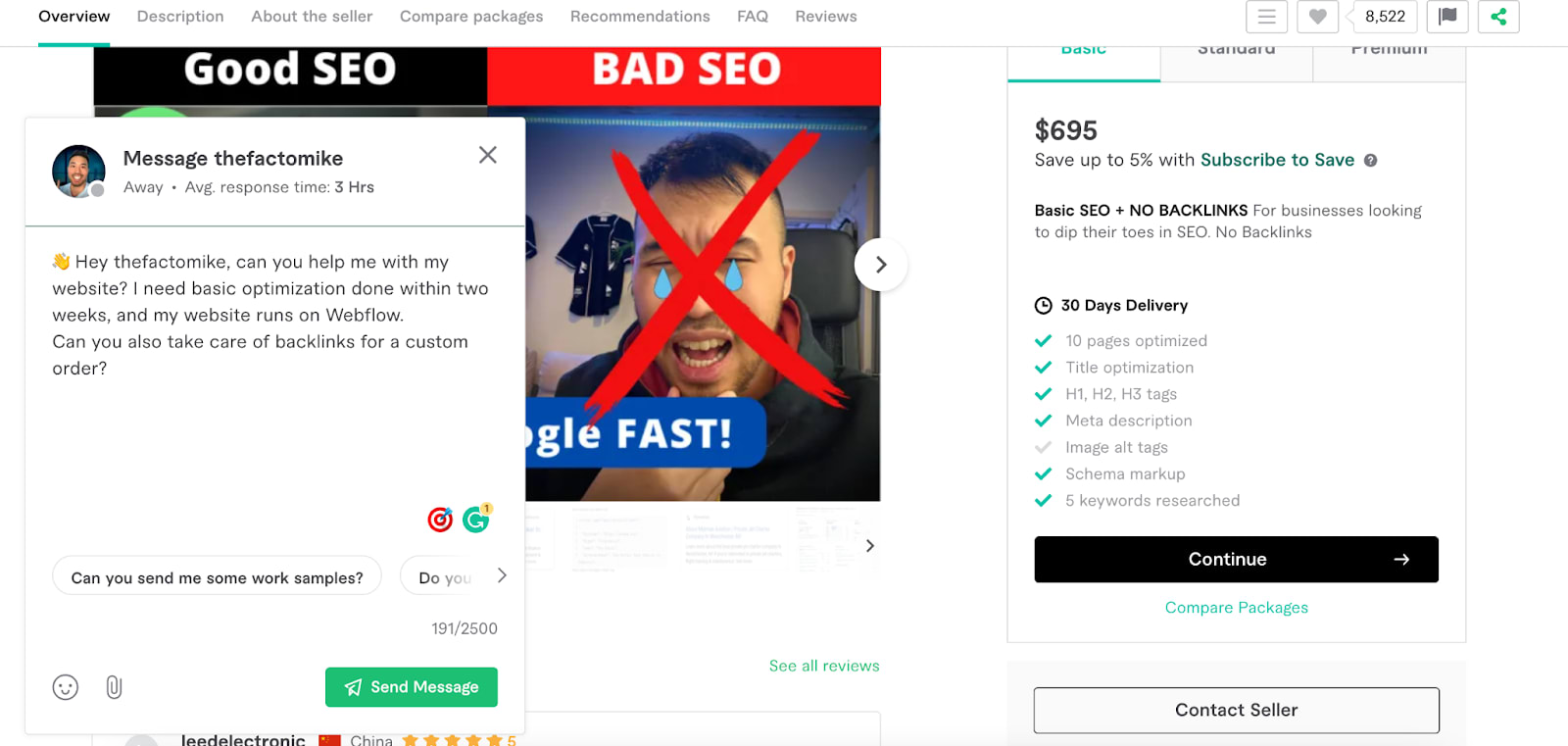
Source: Fiverr thefactomike
The Fiverr seller should get back to you in a couple of hours with a quote and more details. You can also contact another seller to compare prices and quality.
Step 4: Vetting Freelancers
When hiring full-time employees, there’s usually a well-defined interview and selection process in place. Small businesses without an HR department quickly develop their own interview process to search for skill, experience, and culture fit.
There’s no reason you can’t follow a similar process when vetting freelancers.
We’ve created a simple vetting process from our conversations with business owners, and what worked for them.
Read reviews and recommendations
Do you read Yelp reviews before heading to a restaurant? It’s easier to try something new when you see others vouching for it.
If you’ve found a Fiverr freelancer, there will be plenty of reviews on their seller page. Read both their 5-star and 1-star reviews to get a well-rounded analysis.
Critical reviews can reveal a lot about the freelancer. If the review is vague or says ‘weren’t happy with the output’, this could point to communication or briefing issues and isn’t necessarily the seller’s fault. Most sellers will respond to bad reviews with an explanation of what went wrong. Pay attention to reviews that talk about unclear communication, under-delivering on promises, not meeting deadlines, or other issues.
“When I hire freelancers from Fiverr, I read the reviews. I take all of that under advisement before I hire somebody so I can be confident in their ability to do high-quality work,” says Lisa Riggs.
If you’ve found a freelancer off Fiverr’s platform, their Linkedin or website will likely have recommendations from their previous clients.
Ask for a portfolio
Remember when we spoke about including previously completed projects in a job description? Asking a freelancer for work samples or a portfolio has a similar purpose. It allows them to show you their experience, rather than tell you.
For freelance services like content writing, graphic design, or website development, portfolios are essential to gauge skill level.
Other freelance services, like marketing strategy and virtual assistance, may not have tangible work samples to share. In this case, ask them for case studies, a website, or a few brands they’ve worked with before.
“Hiring freelancers can be a very low-risk undertaking,” says Alli Hill. “Always start by checking their portfolio. If you like what you see, offer a paid test.”
Give them a paid test
Full-time positions based on hard skills usually have a test as part of the interview process. The applicant works on these tests hoping to get the role.
But with freelancers, paid tests are widely accepted as the norm. A paid test compensates the freelancer for their time, even if you don’t go ahead with them.
It also safeguards freelancers from a client who rejects them but ends up using the work.
A paid test should be similar to the project’s scope of work, but not too extensive. Ideally, give them a brief assignment that won’t take more than a day or two.
When you receive their test work, compare it to their portfolio. A paid test can help weed out fraudulent freelancers.
Through a paid test, you can weed out the bad apples before any longer commitments. For example:
You catch a big difference in portfolio quality and paid test quality. They might have plagiarized work in their portfolio.
They make fundamental errors in the paid test. You realize they do not have relevant prior experience or did not understand the brief and instructions.
They don’t deliver by deadlines. Poor work ethic is a big issue.
“When we've hired freelance writers, we start with one article, before we ramp up our work together.” says Alex Kracov, CEO of Dock. “This allows us to test our relationship and see if we like working together.”
Karli Jaenike also assigns a paid test project before she commits to a long-term relationship with a freelancer. While this process has usually worked well for her, she has also encountered freelancers who over-promise and under-deliver.
“You have to cut your losses, think about how much worse a long-term engagement would have been, and tweak your processes in the future.” she says.
Interview them
When hiring freelancers, interviews tend to be quicker and more focused on project completion.
You might want to ‘hop on a call’ vs. conducting a formal interview with your prospective freelancer.
While interviewing, stick to questions about their skill and experience.
Stay away from generic interview questions like “What are your strengths and weaknesses?” and “Where do you see yourself in five years?”. Instead, ask “Have you worked on a similar project before?” and allow them to share their experiences.
Here’s a free template for freelance interview questions!
It’s a two-way street — allowing room for the freelancer to offer insights or advice. Freelancers have worked with multiple companies and can have great tips to offer from their vantage point.
“One of the most valuable things you can do is ask your freelancers if they see any opportunities for you to be more organized or streamlined,” says Kayla Ihrig, Freelance Writer, and Pinterest Marketer. “We may be able to make your life easier in more ways than one.”
Step 5: Create an SOP
Now that you’ve found your freelancer, having a well-defined workflow will help your project go smoothly.
Create a standard operating procedure for your business. The idea is to have a system in place you refer to whenever you hire freelancers.
This SOP can be bare-bones or as detailed as you want. If you’ll be working with multiple freelancers for one-off projects, it’s best to put a detailed workflow in place.
“I always record Loom videos that explain the project as deeply as I possibly can,” says Luciano Viterale, and recommends creating similar resources that freelancers can keep referring to.
However, highly specialized and experienced freelancers might have their own SOPs in place.
“Most clients don’t have their own SOPs, which I actually kind of prefer because they usually welcome the structure that I bring,” says Kayla Ihrig. “It took me over 2 years to streamline my process — I send an intake form, FAQs, and an onboarding timeline with weekly project milestones.”
Choose communication channels and project management tools
While you might reach out to a freelancer by email, it’s difficult to keep up conversations and manage multiple threads. Most business owners we spoke to prefer using Slack or a project management tool like Asana.
“When onboarding freelancers, I get their payment info and familiarize them with my company and the client,” says Karli Jaenike. “Then I add them to our Slack channel so they can easily ask questions. Lastly, I add them to our Monday.com board so that they can see upcoming tasks and receive feedback there.” Lindsey Walker allowed access to an executive portal on her website for freelancers to use. She also uses high-collaboration approaches to keep in touch with her freelancers.
“Additionally, we have 15-minute huddle meetings daily, and frequent work sessions.”
Create milestones
A deadline is great, but milestones work better.
Create multiple checkpoints throughout the project duration. Not only does it help in distributing tasks evenly across the engagement, but it also allows you an opportunity to course-correct and review.
Of course, no one likes a micro-manager. As you complete multiple projects and build more trust with your freelancers, ease into a more hands-off approach.
Use Fiverr Business
Fiverr’s Business Tool is a project management and collaboration tool. It helps you communicate with highly skilled and vetted freelancers, collaborate with core team members, and process payments on one platform.
Give constructive feedback
Among the many enviable skills your freelancer has, mind-reading is not one of them. If they’ve made a mistake or are going in the wrong direction, constructive and detailed feedback will help them with editing and corrections.
Kayla Ihrig talks about generic feedback being unhelpful. “A client asked me to design a logo with a red circle and their name in the middle of it. When I sent them the file, they said “it looks weird” with no further feedback.”
Giving constructive feedback involves being specific about the problem and mindful of the other person’s feelings. In the earlier example, the client could've explained why the logo ‘looked weird’, regarding the size of the text, font, color, or even a reference example close to what they’re looking for.
If the feedback comes across too harsh, point out the positives to balance out your response. And when your freelancer does a good job — don’t be silent. Positive feedback can be the difference between a great client relationship and an average one.
We asked Ihrig what makes her want to work long-term with a client. “An email that says “thanks” from a client versus an email that says “you did it again - I love it!” is a no-brainer choice.”
Step 6: Retain a long-term freelance team
If you have long-term freelance requirements, creating a dedicated freelance team is important. The last thing you want is to go back to square one and hunt for new freelancers again, particularly if you’ve struck gold with the ones you’ve already found.
Freelancers prefer working with the same clients for longer engagements. There’s a better working relationship and the guarantee of consistent income.
“The longest I have worked with a client is 2.5 years. I usually work at least 90 days with a client,” says Stefano Curcio, a freelance lead generation consultant.
A lot of small business owners view freelancers as a short-term solution, but long-term freelancers can take on a consultant role within your organization. They grow with your business and can be invaluable resources. “The longest client relationship I have is someone that I’ve worked on projects with for 8 years,” says Kayla Ihrig.
Long-term freelancers understand your business and vision at a personal level, providing a deeper knowledge base and a familiar support system. Your business gets to enjoy retaining perks and a healthy professional relationship, without employee turnover costs.
If you’re keen on retaining a freelancer, conduct a debrief session with them after project completion. Ask them how their experience has been, and what you can do better for future projects. You can also leave them a review or recommendation.
Do you need a contract to hire a freelancer?
Contracts are legally binding agreements that can protect the interests of both you and your freelancer.
With a legally-binding contract, you must adhere to the payment terms, and the freelancer has to complete the project to get paid. This brings more structure and clarity to the relationship so you’re not relying on word of mouth.
The contract should detail the following:
Scope of work during the time period
Non-compete clause
Confidentiality clause
Payment terms (Net 30 or 45, mode of payment, payment in advance)
Termination clause (what happens if either party terminates the project early)
Most freelancers will send you a contract to sign, but you can create one yourself if they don’t.
When you work with Fiverr freelancers, there’s no need to create an external contract. All jobs are done with Fiverr's standard service agreement that protects your investment and interests. Your payment isn’t processed to the seller before you approve the work done.
“I also recommend having a basic contractor agreement on file so you aren't only relying on the freelancer to provide a contract,” says Andrew Gonzales. “But it’s even easier when using platforms like Fiverr that have contracts baked into the process.”
Retainer Agreements
Enter retainer agreements with your freelance team. This is usually done with a legal contract signed by both parties, the client and the freelancer.
Retainers can have fixed pricing (similar to part-time employees) for a consistent workload. If you need to get extra work done, this can be charged hourly/or project-wise as well.
For example, Digital Marketing Analytics is a continuous process for most businesses. You can enter into a retainer agreement with an expert marketing freelancer to monitor and measure digital marketing performance over six months, with a stipulated monthly fee. Extra work can be done on a pro rata basis, and you can renew the contract after six months if you have more requirements.
Start looking for the right freelancer for you
If you're new to the freelancing world, the delegation process and workflow can feel ambiguous. Working with a freelancer won’t be as well-defined as compared with full-time employees. However, this disruption in traditional structure can foster innovation, and greater efficiency, and give your company an edge.
In 2023, the gross volume of the gig economy is projected at 455.2 billion U.S. dollars. It’s the perfect time to leverage freelance talent, save resources, and get ahead of the competition.
By using Fiverr’s freelancer platform, all you have to do is pick the right person for your job and start working with them. The rest — contracts, payment structures, invoices — is taken care of by the platform.
Ready to hire your first freelancer? Sign up on Fiverr today!



